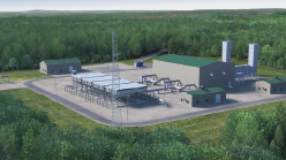The Foundation is pleased to announce the release of North American Midstream Infrastructure – A Near Term Update Through 2025. This report, developed for the Foundation by ICF, a global consulting and digital services provider, examines how the pandemic has affected oil and gas markets and midstream infrastructure, and how those impacts will ease over the next five years.
As the effects of the pandemic subside, markets will rebound as demand returns. Domestic natural gas use and exports are expected to rise prompting further infrastructure development.
Related Documents
Accelerated Growth of Renewables and Gas Power Can Rapidly Change the Trajectory on Climate Change – GE, December 2020
In a recent whitepaper, GE reports that accelerated and strategic deployment of renewables and gas power can change the trajectory for climate change, enabling substantive reductions in emissions quickly, while in parallel continuing to advance the technologies for low or near zero-carbon power generation. The industry needs to increase the public’s awareness that natural gas complements and supports renewables through flexible, dispatchable power whenever needed.
https://www.ge.com/news/press-releases/ge-releases-position-on-climate-change-calls-for-accelerated-deployment-of-1
ISO / RTO Insights from NARUC 2020 Summer Policy Summit – ICF, July 2020:
The electric system is getting cleaner and greener, with many electric utilities pledging significant carbon reductions by 2030 and 2050. COVID-19 impacts have helped to highlight the importance of a resilient power grid. There are calls for the nation to move faster and shift entirely to renewable resources, whereas others contend that natural gas will be needed far into the future due to the flexibility of this resource. Regional transmission organizations and independent system operators are charged with integrating renewable resources and other low-carbon resources into the grid.
2020 Long-Term Reliability Assessment – North American Electric Reliability Corporation, December 2020
Long-Term Reliability Assessment finds the evolving fuel resource mix is changing reliability, security and resilience landscape. “As more solar and wind generation is added, additional flexible resources are needed to offset these resources’ variability. This is placing more operating pressure on those (typically natural gas) resources and makes them the key to securing Bulk Power System (BPS) reliability. Insufficient flexible resources was a contributing cause to the load shed event in California during the wide-area heat wave in August 2020.”
https://www.nerc.com/pa/RAPA/ra/Reliability%20Assessments%20DL/NERC_LTRA_2020.pdf
Implications of Policy-Driven Residential Electrification, an American Gas Association study prepared by ICF, July 2018
As states and local municipalities pursue “deep decarbonization” of their economies and as the electric grid becomes less carbon-intensive some policy-makers and environmental advocates are looking at mandated residential electrification as one option for reducing residential greenhouse gas (GHG) emissions. This AGA study sets out to answer several key questions regarding potential costs and benefits of these residential electrification policies.
https://www.aga.org/globalassets/research–insights/reports/AGA_Study_On_Residential_Electrification
U.S. Oil and Natural Gas: Providing Energy Security and Supporting Our Quality of Life, U.S. Department of Energy – Office of Fossil Energy, October 2020
Over the past two decades, we have witnessed dramatic growth in our nation’s ability to produce the oil and natural gas needed to power our vibrant economy and support our modern lifestyle. This report focuses on the important benefits this increased supply of domestically produced energy, and the key advances in oil and natural gas production technology that made this growth possible. DOE’s Office of Oil and Natural Gas produced this report to recognize the critical role of advanced energy technology innovation in maintaining U.S. economic success and providing a sustainable domestic energy supply for the future.
https://www.energy.gov/sites/prod/files/2020/10/f79/Natural%20Gas%20Benefits%20Report.pdf
New Lifecycle Analysis Of U.S. LNG Exports – American Petroleum Institute Study, July 2020
A study released by API and conducted by researchers at ICF examines the environmental benefits of U.S. natural gas use in China, Germany, and India, finding that using U.S. liquefied natural gas (LNG) rather than coal for electricity generation produces on average 50.5 percent fewer greenhouse gas (GHG) emissions in all base case scenarios studied.
https://www.api.org/news-policy-and-issues/lng-exports/new-lifecycle-analysis-of-us-lng-exports
https://www.api.org/-/media/Files/Policy/LNG-Exports/2020/APIUS-LNG.pdf
https://www.api.org/-/media/Files/Policy/LNG-Exports/2020/API-ICF-LNG-LCA-Study.pdf
Economic Forecasting Survey – The Wall Street Journal, September 2020
Overall Economy Is Recovering Faster Than Economists Expected
A rebound in growth in the third and fourth quarters isn’t expected to make up for ground lost earlier in the year.
World Energy Outlook 2020 – International Energy Agency, October 2020
Based on the recently released World Energy Outlook 2020 report, the International Energy Agency (IEA) projects that the global oil demand will not reach 2019 level until 2023 in the Stated Policies Scenario.
https://www.iea.org/reports/world-energy-outlook-2020
IEA, Energy demand by scenario, 2018-2030, IEA, Paris
https://www.iea.org/data-and-statistics/charts/energy-demand-by-scenario-2018-2030
Natural gas generators make up largest share of U.S. electricity generation capacity – U.S. Energy Information Administration, October 2020
Based on the U.S. Energy Information Administration’s (EIA) annual survey of electric generators, natural gas-fired generators accounted for 43% of operating U.S. electricity generating capacity in 2019. These natural gas-fired generators provided 39% of electricity generation in 2019, more than any other source. Most of the natural gas-fired capacity added in recent decades uses combined-cycle technology, which surpassed coal-fired generators in 2018 to become the technology with the most electricity generating capacity in the United States.
https://www.eia.gov/todayinenergy/detail.php?id=45496
Mid-Year 2020 Situation & Outlook – The American Chemistry Council, June 2020
The INGAA 2020 projection for industrial gas use relies on industrial production growth rates recently forecasted by the American Chemistry Council.
Mid-Year 2020 Situation & Outlook, June 2020 – PowerPoint
Industrial Sector Consumption of Natural Gas Falls Amid Slowing Economy – Today in Energy, U.S. Energy Information Administration, September 2020
Declines in industrial gas use due to the pandemic vary by industry, with primary metals, petroleum, coal products, paper, and the chemicals industries affected more than other industrial processes that use natural gas.
https://www.eia.gov/todayinenergy/detail.php?id=45196
NextDecade Delays Texas LNG Export Project Investment Decision to 2021 – Reuters, May 2020
With the collapse of global energy demand, several oil and gas companies have pushed back decisions on building new LNG terminals. For example, the Final Investment Decision (FID) for NextDecade’s Rio Grande LNG project has been delayed until 2021 due to challenging market conditions.
Sempra Energy Announces FID For Landmark Energía Costa Azul LNG Export Project – Sempra Energy LNG, November 2020
Sempra has recently announced that it reached an FID for Energía Costa Azul LNG (ECA LNG) project on November 17, 2020 and LNG production from ECA LNG Phase 1 is expected to start in late 2024.
https://www.sempra.com/sempra-energy-announces-fid-landmark-energia-costa-azul-lng-export-project
World Energy Outlook 2020 – International Energy Agency, October 2020
Oil markets will not rebound to pre-COVID levels until 2023.
https://www.iea.org/reports/world-energy-outlook-2020
Total Energy – Monthly Energy Review, U.S. Energy Information Administration, August 2020
Natural Gas exports have already begun rebounding from the lows set in Q2 2020.
https://www.eia.gov/totalenergy/data/browser/index.php?tbl=T01.04B
From the Barrel to the Pump: the Impact of the COVID-19 Pandemic on Prices for Petroleum Products – Monthly Labor Review, U.S. Bureau of Labor Statistics, October 2020
The pandemic affected energy prices for products ranging from crude oil to various refined petroleum products, such as heating oil, jet fuel, diesel fuel, retail gasoline, and gasoline at the pump. The onset of the pandemic led to an initial drop in prices for petroleum-based products, and then, just as abruptly, prices rose sharply as producers limited production and demand increased.
https://www.bls.gov/opub/mlr/2020/article/from-the-barrel-to-the-pump.htm
San Jose Bans Natural Gas in New Commercial Buildings – San Jose Spotlight, December 2020
San Jose bans natural gas in new commercial buildings.
https://sanjosespotlight.com/san-jose-bans-natural-gas-in-new-commercial-buildings/
LNG Investments Vanish in 2020 as Coronavirus Slashes Oil and Gas Prices – Reuters, September 2020
Delays in LNG Projects in 2020 – Global Energy Monitor, June 2020
https://www.gem.wiki/Delays_in_LNG_Projects_in_2020





